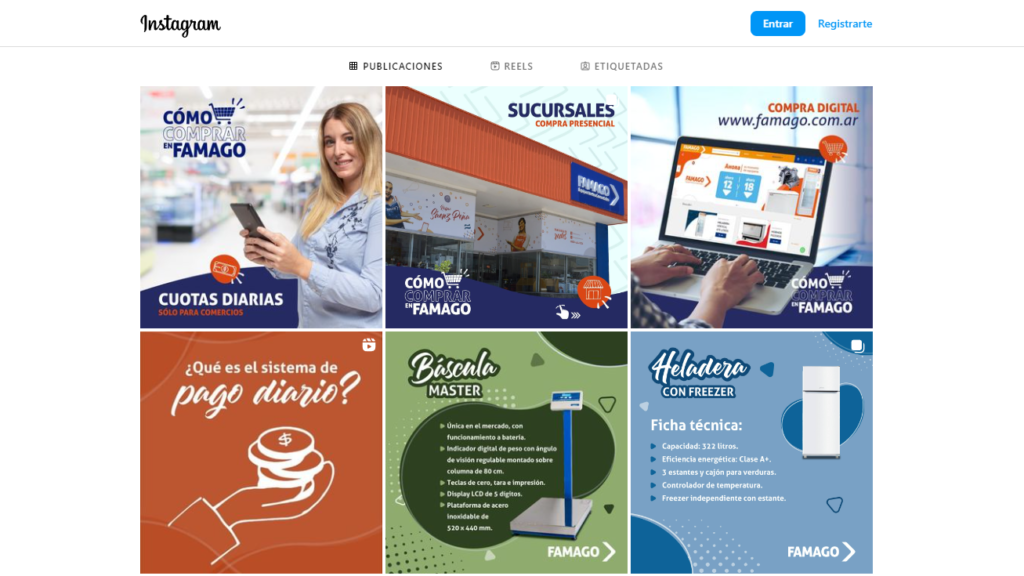Good for something? Do you have to be there? How much do I invest? So that?
Social Networks are on everyone’s lips, we already know, but for many companies they continue to be an enigma that is impossible to decipher. There is a common place, an idea shared more or less by everyone, that “we have to be there” or that “we have to move the networks” and that there are people who do that, professionally let’s say. But let’s be honest, most would not know how to specifically describe what they do on networks, for what and how.
If you’re worried about your brand’s role on social media, or unsure of what you’re doing, or think you could do it better, you’ll probably want to keep reading. In this article we are going to try to put data that illuminates where there are shadows, to share experiences where there is uncertainty, and to bring steps, where the task seems impossible. Let’s just go:

Why?
Simon Sinek, a guru whom we follow a lot, suggests in his famous “Start with Why?” that every project or undertaking should begin by finding its reason for being, its meaning. Applying this logic to the topic of Social Networks, we should then answer this question before moving forward: Why Social Networks? Intuition, or the strength of tendencies perceived with sensation, is of little use to us here. There is a certain consensus that networks are important and we must use them, but we know from experience that when things get complicated or the task requires resources and efforts, intuition is not enough and in most cases, projects are they collapse That’s why we need data; Data can offset losses and bet on the future and the long term, sensations cannot.
We are going to base it on a report that we love, although the figures are similar in other sources: We are talking about the great report from We Are Social. Let’s go with the data.
- 60% of the world’s population (71% in South America) are active users of social networks and this group grows 3% year after year (137 million new users each year, that’s like 3 Argentinas). We already have a first piece of great data to justify our dedication to social networks: It is likely that 6 out of every 10 customers of your brand use social networks, and that proportion increases every year.
- Internet users (68% of the world population, 80% in South America) between 16 and 64 years old spend an average of 2 hours and 31 minutes a day using social networks. This means that networks are the 2nd most dedicated channel, just 1 hour behind TV along with streaming, and surpassing radio, podcasts, and news media. And this time increases year after year at an average of 3.5%.
- 28% of social media users say that one of their main reasons for doing so is to seek inspiration for making purchases.
- Internet users have on average social media profiles on 7 platforms.
Well we don’t want to overwhelm you, the point is already clear, right? Just in case, we summarize it: It is very likely that your brand’s audiences use social networks in large proportion, for a long time, with purchasing intentions and on various platforms. That is precisely why it is important to be there.

So that?
Once we assume the need to do so, a second question appears that is equally or more important to address: why? Why should a company generate content and develop profiles on social networks? With what objective/s?
These questions are more difficult to answer in general but even more in particular since for each brand or company, the answer varies. But we are not going to avoid this challenge here and we are going to try to collaborate on this matter.
Below we are going to list some of the main reasons why a company or brand would develop its communication on social networks. We are also going to mention which metrics would be important then in each case.
We could say that a brand on social networks looks for one or more of these variables, with different priorities:
- Positioning: Occupy a place in the market, and in the minds of your potential clients. Through its communication on social networks it seeks to conquer or defend that place. To this end, the fundamental metric will be reach, although interaction on relevant topics and quality followers will also be important.
- Validation: Provide confidence to the eventual buyer who is considering contracting or purchasing a good or service. The brand does not fundamentally seek to attract new audiences but rather, to provide content to those interested who want to know more but prefer to search on social networks rather than Google. The fundamental metric in this case will be visits to the profile or in some cases visits derived from the site.
- Interactions: Build relationships with users through their interactions with the brand, learn and measure their opinion about it, influence their consideration. The fundamental metric in this case will be the level of interaction of the audience with the content (engagement).
- Followers: Increase the audience that follows the profile in question, to have greater communication and reach capacity. At the same time, it works in many cases as a validating element. The fundamental metric to follow in this case will be the number of net new followers.
- Visits: Achieve traffic (visits) from social networks to the brand’s website, to achieve other objectives there (time spent, registration, queries, downloads, purchases, etc.). The fundamental metric will then be clicks on the link (measured from Meta) or better yet, sessions on the site from this source (measured from Google Analytics).
- Contacts: Generate inquiries by direct message or WhatsApp that later become sales. It can be in the form of logs or simply messages. The metric to follow in this case will have to do with conversations or completed forms.
- Sales: Increase sales volume directly from social media profiles. In these cases, companies use product catalogs and tag products in publications, generating direct sales from the platform to the website in question. In this case the metrics focus on conversions, specifically measuring sales and billing.
Having listed the different objective options, we are left with the major task of determining how to prioritize among them. We leave this work for each particular case, since any prior resolution scheme would be somewhat imprecise and unfounded if we do not know the details of each brand. We are available if you want to consult us now!

How?
Now that we have defined why to do it and with what objectives, we embark on the question of the method, of how, how to carry out an adequate communication strategy on social networks? Let’s get to the answer:
At Digital JUMP we have been working on the social networks of different companies for more than 6 years, and we have been in charge of more than 50 brands. We do not want to be self-referential, but over time we have developed a method that we understand is the best way to do it well. Even if you are not an agency, and the person who approves the steps is not a client but a boss or the owner of the company, the process will still serve you. Here we are going to share with you one by one the steps of our method:
- Relevamiento: This is the first instance of the process and is essential. At this stage we collect all available information about the brand and the products or services it offers. When we say information we are talking not only about data but also about documents, designs, photos, videos, etc., everything that can help us understand the company’s business model, identify audiences, establish objectives and key messages and build a correct plan. In this step our dream is to find a brand manual (if you want to know what it is, visit this complete post), full developed, with clear conceptual and visual elements and without contradictions. With this at our disposal the path is much easier, but when it is not there we can work anyway.
- Objectives: Based on the survey, we define what are the objectives to pursue through the communication plan that we define, and what are the metrics that we are going to follow. Ideally, we define each objective sought with specific numbers so that we can know, month by month, whether they are achieved or whether they need to be corrected.
- Set Up: In this instance, based on what has already been done, we create profiles on social networks if necessary, and if they already exist, we verify that their configuration is correct. We refer here to available information, biography, feed, featured stories, audiences, tracking pixels on the site, product catalogs, etc. In each case, we need to ensure that the profiles are optimal to receive visits and followers.
- Section design: Based on the survey, we build sections, types of content on which we are going to develop communication. One section, for example, could be advice (whether for use, maintenance, whatever), in it the main photo and the text vary from post to post, but the general design, the format of each element, generally it keeps. We leave you here 2 applications of 2 different sections, from 2 different brands as an example to explain what we call a section.
The sections are a key element for us, they allow us to transmit the main messages that a brand wants to communicate and at the same time they guarantee that the way of doing so is in accordance with the brand’s guidelines, allowing the user to get “accustomed” to the type. of content and learn how to consume it and what you can find in each case. Of course, the sections are approved or modified and reviewed every 3, 6 or 12 months, depending on each case, some remain for a long time and others for just a short time.


- Content planning: Based on the sections, we plan a one-month content calendar for each platform in question. We work on a project management system (PMS) in which we share their own calendar with each partner. In each planned post we incorporate the data necessary to develop the content: audiovisual material, text (copy), interaction, call to action (CTA), format, etc. Each date and content is planned taking into account what we foresee may happen around the date and the context, combined with what we already have available from the survey and the sections. What we seek to achieve is relevance, that is, content that interests target users. This planning is validated by the partner.
And real time? Yes, there are times and situations that require unplanned communications: a product is out of stock, an urgent promotion was launched, or there is simply a trending opportunity that we can take advantage of. To meet these needs, we reserve part of the contracted calendar resources to resolve the necessary content in a timely manner and publish it. We always measure whether the effort we make makes sense in terms of the results it can achieve.

- Content design: Our designer or audiovisual editor (depending on the case) is in charge of receiving the planning and transforming the orders into final content ready to publish. Based on the brand brief, manual if there is one and the sections that we have already prepared, your work is much simpler and the content achieved is better. From now on, the contents are approved by the final person responsible for the client (Partner for us), or changes are requested. This entire process happens in our management system and each change or comment is recorded in each content, nothing is published without approval.
And the material, the crude ones? It is true, the preparation of content always depends on what we call “raw” or “raw material”, which are nothing more than photos and videos, which serve to show what we want to communicate. It is essential to have this material and it is usually a factor that strongly enhances or limits the quality of the content and therefore the power of its results.
In cases where there is a lot of material, we work to have it available and organized, in folders that we share. In those where it is completely non-existent, we propose and insist (a lot) on making specific raw content productions. Sometimes we make it, sometimes we don’t. The suggestion is to always do it, since it is the base from which we start when communicating on most social networks: the image. - Programing / Post: Once the contents have been prepared and approved, we proceed to program them. That is, in cases where we can schedule the publication in advance, we do so, so as not to depend on it at all times. In other cases in which we cannot do so due to the platform or format, we schedule the task to publish the content when it should be published.

- Promotion: The organic reach (without investing in advertising) of publications on most platforms (at least Facebook and Instagram) has been declining for some time, and is increasingly difficult to achieve. Therefore, to disseminate the content and, above all, adequate segmentation, there is an alternative path, which is to promote the content. In all calendars, we define what content we are going to promote, with what objectives, budgets and audiences. In general, we select those that are the most attractive to users but that also transmit central messages of our strategy. Sometimes we simply promote all of them, although not with identical budgets.
Influencers? Yes or no? In search of increasing the reach of our content, in addition to promoting it, we can establish alliances or establish collaborations with influencers: social network profiles with a good number of followers, ideally target audiences that can help us in dissemination. It is essential in these cases to properly select the profiles and establish clear agreements by supervising the collaboration format to maximize the results achieved and avoid damage to reputation. - Report: Just as we said that we establish objectives and metrics to follow, we build a specific report for each platform where we track the selected variables and contrast them with the expected results to understand if what we are doing works or if we require corrections. We also better understand how each content works to enhance our advantages. Finally, this allows us to give better visibility to those who do not work day to day in the networks about how what we do is turning out.

What?
We have to admit that we argued about including this section in this note. Writing about what to post on social media, without talking about a particular company, is an immense challenge and involves risks, so we decided to do it.
We are going to focus on the general, that is, on what helps us decide, select and plan, as elements to take into account, and not on the decisions we make in each case, which of course always vary.
We have to say here that one of our main guidelines when creating content is, at the same time, one of the four pillars of our agency: USER FOCUSED.
It means that we think about the content by putting ourselves in the feet of the target audiences and trying to guess what content they may be expecting or better yet what content they are not expecting but would enjoy. It is a very difficult job to do that requires a lot of empathy and common sense. The more foreign the brand is to the community manager’s profile, the more talent and effort it requires, but it is undoubtedly a key element.
Of course, we incorporate the brand’s perspective into this work, that is, we combine the messages to be transmitted with the users’ interests to create RELEVANT content for both.
There is no less attention to modes of communication or formats, sometimes how we say it is more important than what. That’s why we spend a lot of time finding the right aesthetic that can effectively convey what we’re looking for.

Who?
The social media strategy is developed and executed by a team of people, of course. A fundamental part of their good performance is that those people are the right ones. That is why here we share with you what are the roles that could participate in work related to social networks. This does not imply that we all need these people, but rather that we seek to explain the different specialties that we must address for the task:
- Partner / Product Owner/ Brand Manager: This role is the final decider, who will approve or modify each instance and the contents. In some companies several brands coexist and there is one per brand, in others it is a single person for the entire company.
- Project Manager: This is the person who will be in charge of organizing what you want to achieve into manageable tasks and organizing those tasks into times and responsibilities to guarantee the desired results. This role must then ensure the correct execution of what was planned and attend to any deviations or modifications that the agenda requires. It is a fundamental role that makes every project and team work and move forward.
- Social Media Manager: Those responsible for social networks are in charge of defining specific strategies for these spaces, as well as coordinating the different related resources that we mention below.
- Community Manager: The CMs are the people in charge of building the communities around each profile and ensuring that they remain active and functional to the brand. In terms of tasks, they must select, develop and publish the content and interaction dynamics that achieve the desired communication objectives hand in hand with the construction of the desired community.
- Influencer Marketing Manager / Analyst: The dissemination of content on social networks increasingly depends on the promotion of advertising or the collaboration of profiles with a large number of followers and reach. These profiles are called influencers and they usually collaborate with brands (that’s what most of them make a living). It is important to have a role that coordinates actions with these people to ensure they are aligned with the selected communication strategy. It is usually a role shared with another Social Media role.
- Graphic Designer: Communication is increasingly visual. With each passing day, as an audience, we spend less time on each piece of content and receive more of it. The graphic designer’s job will be to create graphic pieces capable of communicating efficiently in different contexts.
- Photographer: The photographer is responsible for obtaining the raw material of communication, images. This is usually an external role, which is usually hired part-time or by project or hours, due to the variability in its demand and the specificity of the task (the best event photographer is not usually the best at photographing products in the studio, and vice versa).
- Filmmaker: An increasing proportion of communication depends on audiovisual content; competition for attention forces us to be original in animated formats. For this, it is essential to have someone responsible for the generation of audiovisual images. Among us “the one who films”. Even more so than the photographer, this is usually an external role, which is usually hired part-time or by project or hours, due to the variability in its demand.
- Video editor: Raw images and videos require adjustments in most cases, sometimes tiny and sometimes transcendental. This role is responsible for processing audiovisual material and transforming it into finished content ready to publish. It is also usually an on-demand hired role, except in marketing/advertising agencies or content production companies.
- Paid Media Specialist: Achieving results with the content depends on 2 variables: effectiveness and exposure, on the one hand how capable the content is of achieving what we want the user to do, and on the other hand how many people (the correct ones) and number of times we achieve that be seen. For this second point on platforms such as Facebook or Instagram, we depend largely on the advertising or paid advertising. The paid media specialist is responsible for managing that budget to achieve the objectives with the best possible efficiency.
The keys. Rounding.
It is clear that the statistics justify the participation of the vast majority of brands (of course there are exceptions) on social networks. Defining the desired objectives will provide a framework for selecting a correct strategy to optimize resources and make their use more efficient. Having a method to do it is essential, a set of defined steps simplifies the task and gives it continuity over time. Knowing what to communicate and doing it successfully is a challenge but it is the crux of the matter.
Here we review the points that we believe are key to doing it successfully:
- Having a brand manual or key definitions about brand communication in general will facilitate this project, otherwise we will have to do it as part of the social media strategy.
- Contar con, o producir contenidos en crudo propios, idealmente videos, resulta indispensable para lograr contenidos atractivos que funcionen.
- Planning allows you to produce better results with fewer resources.
- Generating content from the brand is easy, the complex thing is doing it with the user in mind. But it’s what works.
- Creating involves the challenge of taking risks. No valuable content comes from repeating what doesn’t work. We need creativity and creativity involves risks.
- The organic reach is very low, if we do not advertise or collaborate with larger profiles, the content will hardly achieve impact. At least at the beginning.
There is a commonplace that you have to be on the networks. However, there is a lot of ignorance as to why to do it, for what, how and what. In this note we share part of what we do daily, and we hope it helps you improve.
At Digital JUMP we have been doing this for more than 6 years and we have managed more than 50 brands, we are professionals, with a method and experience, who achieve results. If you want us to help you achieve results on social networks, don’t hesitate to contact us! Here we are.


